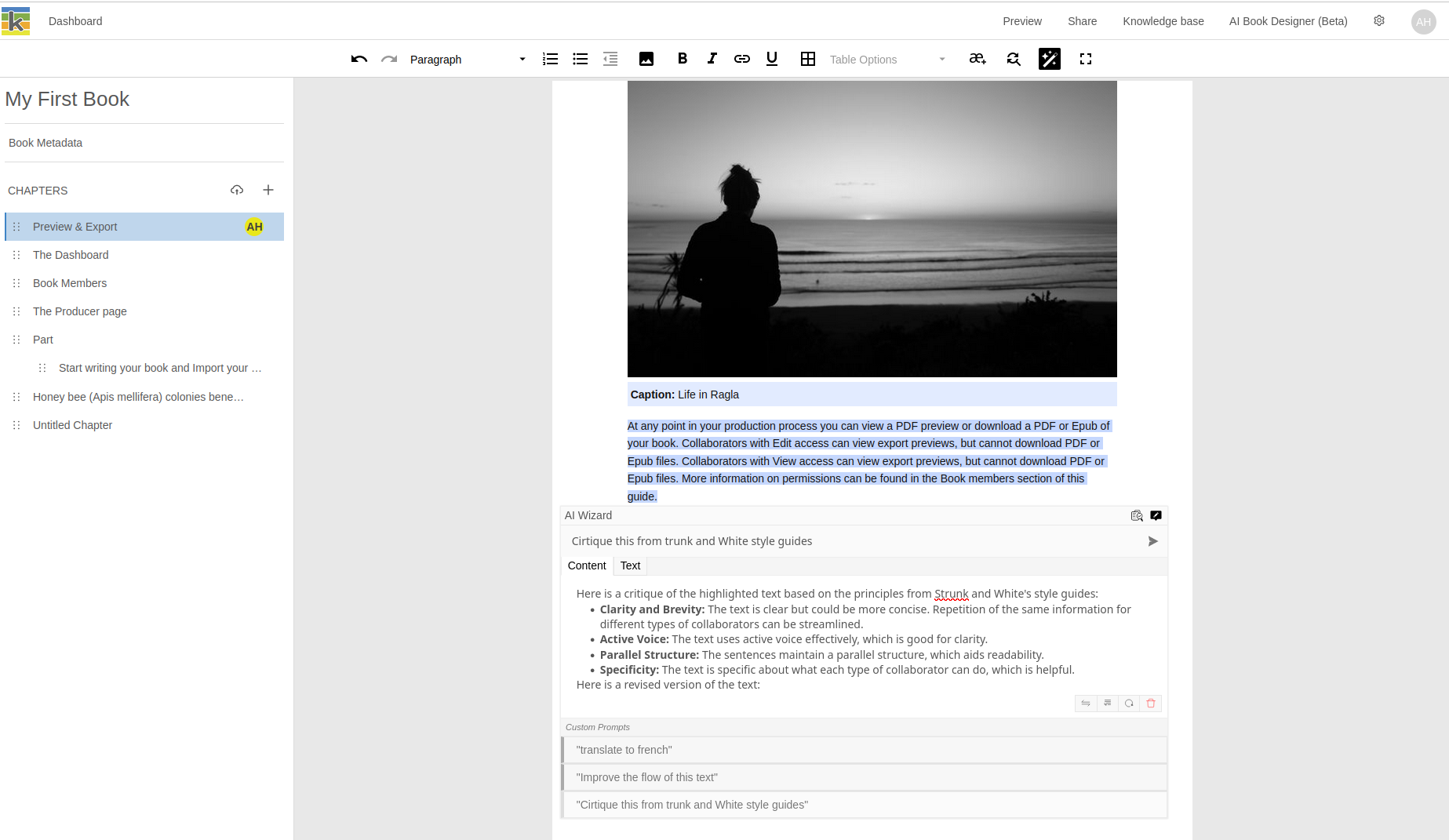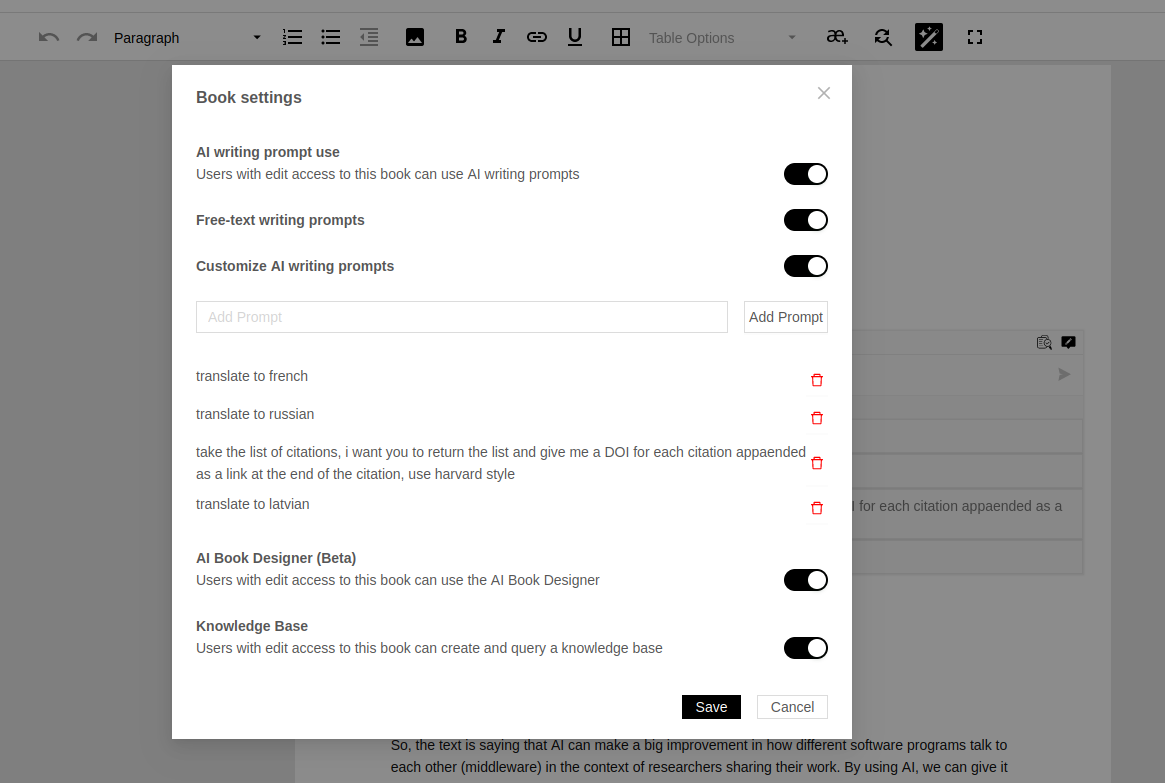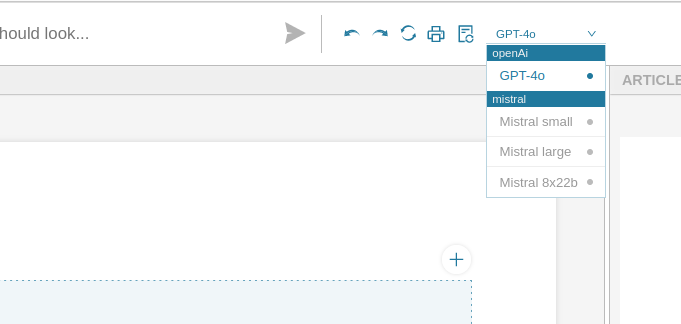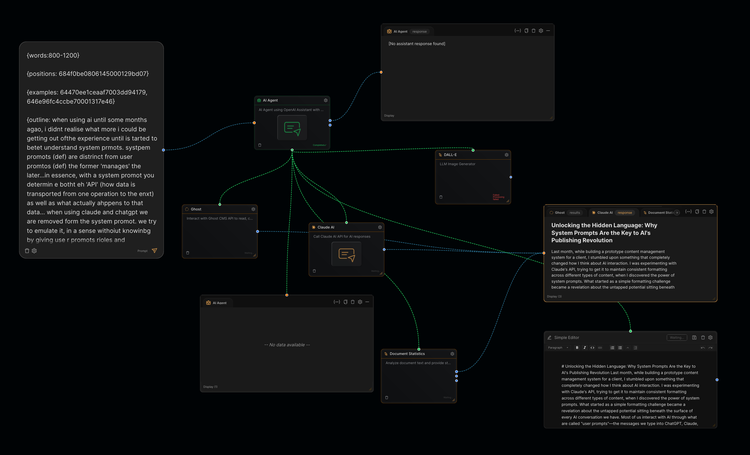Ketty AI

With the forthcoming release of a new, and very exciting, Ketty release I thought I would outline here some of the work we are doing with AI and Ketty to enhance book production workflows.

The main AI developments within Ketty are the AI Assistant, AI Design Studio, Knowledge Base (RAG strategy), and future AI macro extensions.
AI Assistant
The AI Assistant is a cornerstone of Ketty's capabilities, designed to assist users throughout the book production process.
It combines features of free text prompts for LLM text processing of selections and preset prompts configured by the user.
Key features include:
- Text Processing: The AI Assistant employs LLMs to help with text-related tasks.
- Preset Prompts: Users can select from a variety of pre-configured prompts to guide their content creation processes..
- Optional Integration: The assistant can be turned on and off in the settings or directly at the prompt itself.

Planned enhancements include adding interactive chat functionality to improve user experience and encourage users to prefer it over copying and pasting from ChatGPT. Additionally, future capabilities will include returning descriptive captions for images, API integrations (eg for creating charts from arbitrarily formatted data, language identification etc), generating and transforming images, and checking for formal and semantic structural requirements within documents.
AI Design Studio
The AI Design Studio is revolutionizing the print book design process by leveraging PagedJS and AI to create sophisticated and aesthetically pleasing layouts with minimal manual intervention or knowledge of design tools.
Key features include:
- Design Automation: The AI Design Studio can automatically generate complex book layouts from expressive prompts ("make this book look serious"), incorporating elements such as typography, images, and graphical elements.
- Customization for Non-Experts: Users, regardless of their expertise, can tweak and customize the layout using natural language according to their preferences, making the design process accessible to everyone.
- Semantic Snippets: The studio uses design snippets for specific elements (e.g., tables, lists) with descriptive semantics connected to them (more on where this is heading below).
- Real-Time Adjustments: The design tools provide real-time feedback (using the PagedJS preview feature).
In the very near future, the AI Design Studio will become even more powerful with several key enhancements. One significant development is the ability to assemble snippets into templates dynamically. This will allow for more flexible and innovative design options, enabling users to create unique and personalized reusable layouts from pre-defined / pre-designed components with ease.
Additionally, the forthcoming integration with PagedJS pre-made templates will provide users with an expanded range of design possibilities. This integration ensures that users can leverage high-quality, professional comprehensive, pre-designed templates to streamline their design process and achieve polished, sophisticated results. The Design Studio can then be used to refine and personalize the final product.
Knowledge Base (RAG Strategy)
The Knowledge Base leverages a AI technique known as the Retrieval-Augmented Generation (RAG) and enhances the AI Assistant's capabilities by incorporating external documents into the AI's responses. This feature is managed at the user level, allowing for personalized and contextually relevant AI interactions.
Key features include:
- Contextual Understanding: The Knowledge Base allows users to upload any content to provide context for prompts. This feature ensures that the AI can generate more contextually relevant suggestions and content by referencing the specific materials users have uploaded.
- Enhanced Accuracy: By drawing from a broader range of user-provided information, the Knowledge Base significantly improves the accuracy of AI-generated content (vs using a generalized AI). It ensures that the AI's outputs are well-informed and precise, reflecting the nuances and details from the user's documents.
- Citations for Referenced Works: The Knowledge Base provides citations for the works referenced in the Knowledge Base. This feature ensures that users can easily trace the source of information, maintaining integrity and providing proper attribution.
- User-Level Management: Users can upload, manage, and organize their documents within the Knowledge Base interface. This functionality ensures that all relevant materials are easily accessible and integrated into the content generation process, allowing for a streamlined and efficient workflow.
Future enhancements for the Knowledge Base include better ability to segment documents to improve contextual relevance, the ability to push a chapter or book you are working on in Ketty directly into the Knowledge Base, the ability to include or exclude materials from the Knowledge Base depending on the book being worked on, and identifying different types of documents that might be used by the user within the same book for different purposes, such as uploading a style guide and consulting it when doing checks.
AI Macros and Future Developments
Ketty is also developing AI macro extensions and providing configuration to target the use of open-source large language models (LLMs).
- AI Macros Extensions: These extensions will allow users to automate complex sequences of actions, enhancing productivity and customization. Future enhancements for AI macros include the ability to work with external APIs.
- Open-Source LLMs: Targeting integration with open-source LLMs will provide users with more options and greater flexibility in their AI-powered workflows.
Much of this work is already done in our prototypes.

AI Strategy: Optional and Customizable
Ketty's AI strategy ensures that AI tools are entirely optional and customizable. Users are not required to use AI tools if they do not wish to, and the tools can be activated in the settings. Once activated, there is significant flexibility in how each tool is configured by the user. Currently, Ketty targets OpenAI for its AI functionalities, but we have prototypes (as per above) that extend the functionality so users can leverage a diversity of different LLMs including open source LLMs. This approach also acknowledges that different LLMs have different strengths and allows users to target specific LLMs for specific tasks. Importantly, this flexibility will enable users to leverage open-source LLMs, which may be important for philosophical, ethical, legal, or privacy reasons.
Summary
The integration of these AI technologies into Ketty has transformed the platform into a state-of-the-art tool for digital publishing. The AI Assistant, AI Design Studio, and Knowledge Base collectively provide users with powerful tools to streamline the book production process, improve design quality, and enhance content relevance. These advancements position Ketty at the forefront of AI-driven publishing solutions, offering unprecedented efficiency and creative capabilities while ensuring that the use of AI remains entirely optional.
100% Open Source.
© Adam Hyde, 2024, CC-BY-SA
Image public domain, created by MidJourney from prompts by Adam.






Member discussion